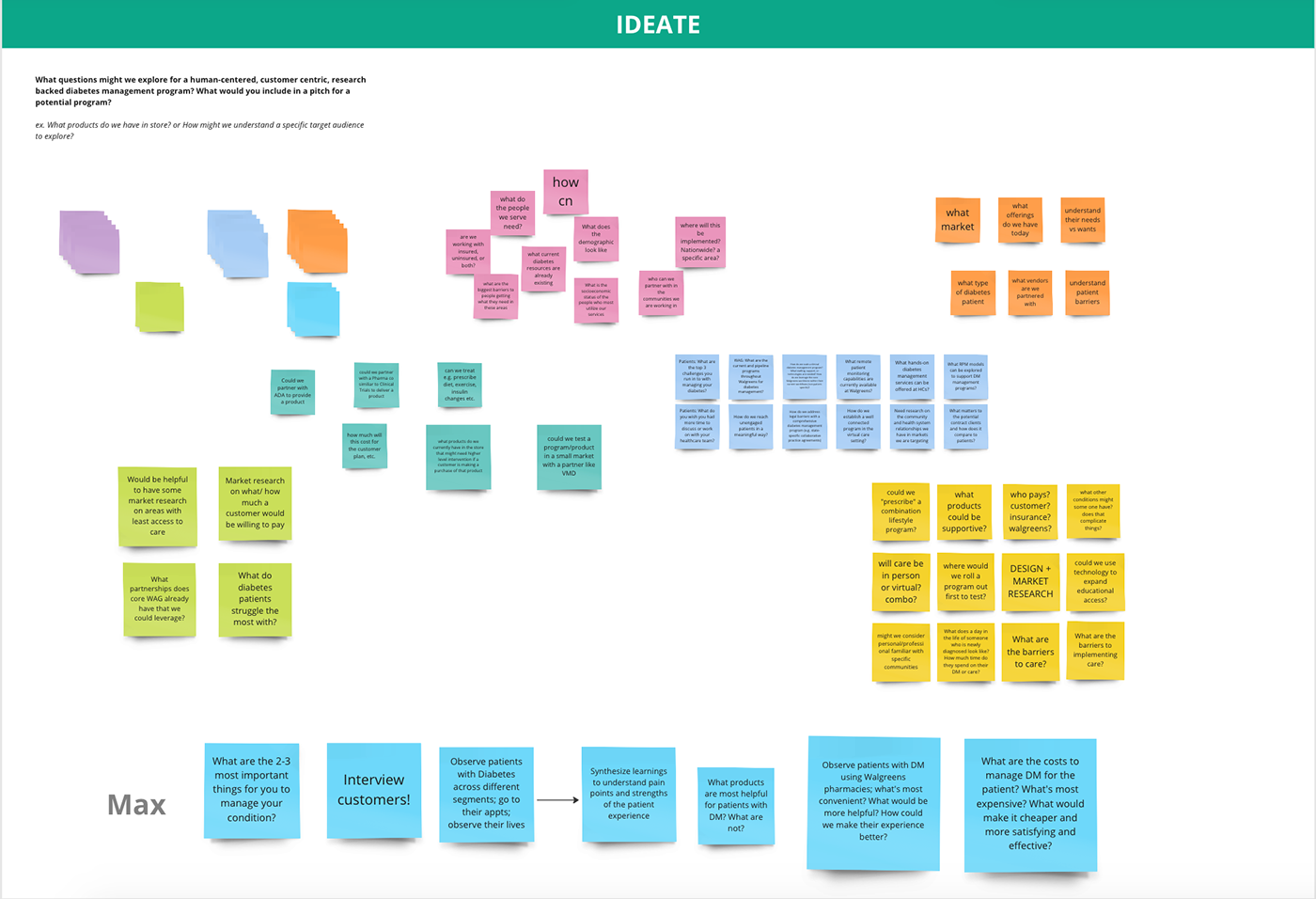
Walgreens Health Diabetes Management Brainstorm Facilitation
The senior leadership team asked for general ideas on a Diabetes Management solution for Walgreens Health, an innovation group of Walgreens. The ask was purposely vague, wanting to see what the collective team could come up with while simultaneously recording our teams brainstorming facilitation process to be implemented across the organization in the future.
I led a 3-part brainstorm facilitation workshop which included a range of internal stakeholders with varying backgrounds: clinical program developers, clinical business strategists, diabetes educator, nurse practitioner, clinical operations lead, ambulatory care pharmacist, and health coaches who have worked with diabetes patients.
Skills and Expertise: Brainstorm facilitation



Workshop Day 1: I designed day one to include "The What", a look into what each person had as an initial idea for a diabetes service based on their own lived experience working with diabetes patients in the past, and "The Who", a way to put the team in the shoes of a Diabetes patient and empathize with them. Knowing the ask was vague and we didn't have the luxury of a design and market research budget at that point, I still wanted to guide the team to empathize with a potential customer.
Part two was an ideation session to keep the teams minds open and to include in our final presentation ideas, questions, and thoughts we would like to consider to understand a more specific audience and build a human-centric product or service.
PART 1: "The What" and "The Who"
The What (10 mins, 7 min share):
From your experience and vantage point, without digging too much into customer research, what would you like to see implemented at Walgreens regarding Diabetes care?
From your experience and vantage point, without digging too much into customer research, what would you like to see implemented at Walgreens regarding Diabetes care?
The Who (15 mins, 7 min share):
Based on your personal "What", who might that customer be? What do they look like? What do they care about?
Based on your personal "What", who might that customer be? What do they look like? What do they care about?
PART 2: Ideate "How might we..." create a human-centric service Ideation (10 mins, 15 min discussion)
How might we create an informed, human-centric service? What background questions might you want to explore (market, customer, products, etc.)?


Workshop Day 2: Day 2's workshop I set up as a way to get the team to tap into the creative side of their brains and spark discussion that might not be so straight forward or obvious. I feel working with constrained prompts and thinking of far out ideas, sometimes unrelated, helps to create a collaborative environment for discussion and gets people excited. Both "sacrificial concepts" and "constraints" are brainstorming ideas I picked up from an IDEO-U course, Human-Centered Service Design.
PART 1: Sacrificial Concepts (7 mins, 7 min discussion)
As the name implies, come up with three to five concepts that you're “sacrificing"—ideas that you know just won't work. By definition, they're meant to be wild, raw, and to push the edges. Think big, think curious.
PART 2: Constraints (7 mins, 7 min discussion)
What would this moment be like if it were all digital?
What would this moment be like if it were only in person?
What would this moment be like if it were only over the phone?


Workshop Day 3: After day 2, I synthesized our discussions and took the teams top ideas to set up for Day 3's journey map concept exploration. The three ideas consisted of: a mobile bus, a simple, accessible, whole care solution through Walgreens, and a pre and early intervention idea.
I broke the team up into 3 different groups, each taking one of the above working concepts to explore a problem statement, solution overview, it's viability, feasibility, and desirability, as well as the start of a journey map which included high level moments, emotions a patient may be feeling, and any supporting notes.
Group work:
Breaking into groups -- 3 different working concept ideas
Write the problem statement, solution overview, and the desirability, viability, and feasibility of the product.
Write out a mock, working concept journey map
What happens pre service?
What happens during?
What happens post?
Describe the moments, the emotions going into the moment, and write any notes




Synthesis and Strategy Presentation: Tristin Chan, a Clinical Program Developer on our team, took our three working concepts and the brainstorm facilitation process and turned it into a presentation we used to present to the senior leadership team. The above slides provide examples of what she presented, showcasing our teams solutions from our rapid ideation sessions.
